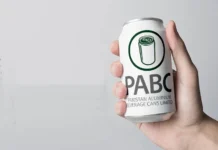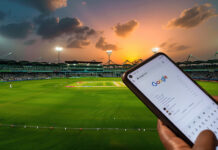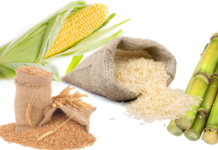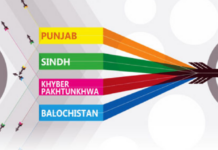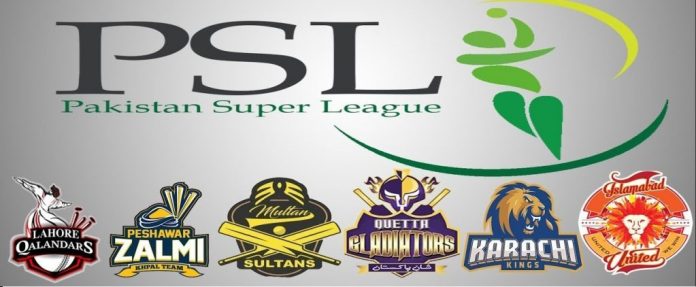The first thing that greets you in the small cluster of sports shops, just a short walk from the Saddar metro stop, is the smell of rubber and old leather. Then comes the sound—bats clinking against one another as they are taken off the racks, the flutter of jerseys being unfolded, the low hum of a pedestal fan that never seems to cool the shop down, no matter how fast it spins.
Inside Al-Hamza Sports, cramped between a tire shop and a kebab corner, 52-year-old Iqbal Anwar is already halfway through his morning, though it’s only 10:30 a.m. He is holding out two different rolls of electrical tape for a teenage boy in a school uniform who is insisting on the “sticky kind”—the one that doesn’t peel after three overs. He also wants it to be pink.
“Two rolls for eighty,” Iqbal says, distracted. “You want that big bat too?”
The boy nods, eyes on the slab of wood leaning in the corner. He had come in to buy just the tape and a couple tennis balls, but he had been sneaking looks at the bat the entire time he was in the shop. Iqbal picked up on it. The bat is a monstrosity. It is a light weight, curved thing meant to hit straight sixes against a tape ball, not the English Willow that players use out in the middle. But when you’re playing in the streets and things get heated, you might as well be out there in the middle of the pitch.
On the side, Iqbal’s son, Bilal, is scribbling prices on a tiny receipt pad nearby, barely keeping up.
It is May, and the HBL Pakistan Super League is back. For Iqbal, this is the month when the numbers shift. Sales that hover around Rs 3,000 to 5,000 per day in the winter swell to Rs 15,000, sometimes even Rs 20,000, especially if Lahore Qalandars or Islamabad United is playing a night match.
“People catch the fever,” he says, folding a stack of polyester Qalandars jerseys, the shade of red just a few tones off from the original. They are obviously rip-offs, not the official merchandise, but they make good money. “And fever is good for business.”
A few blocks away, on a quieter lane in Satellite Town, 38-year-old Usama Imran stands outside his family-run print shop, nervously watching a bundle of placards dry in the sun. His brother, who runs the offset press inside, hasn’t slept properly in three days. They’ve had non-stop orders: “Babar King,” “Go Gladiators,” “Multan Sultans”—each one a splash of ink on thick card, Rs 40 a piece if printed in bulk.
“This is the only time of the year we do colour this cheap,” he says with a laugh. “Otherwise it’s wedding cards and exam notices.”
He estimates they’ll make Rs 100,000 this month if the orders keep coming. That’s nearly twice their monthly average of the off season. The only other time they make this much money is during shadi season.
In Lahore’s G1 Market in Johar Town, things are even more manic. On the edge of the roundabout, Saleem Bhatti is negotiating with a vendor over a new stack of hats. “No, bhai, not the green ones—those don’t sell.” According to him, fans have become picky over the past 10 years. If the shade does not match the colour of the team’s hats, they don’t want them. He waves the man off and turns his attention to two university girls eyeing the racks of shirts stitched with player names.
“Rs 850 for the shirt, Rs 200 for a name on the back,” he tells them. “Fakhar Zaman? Shaheen?”
They whisper among themselves before settling on Haris Rauf. Saleem takes the shirt and ducks into a tiny room behind the shop where his cousin operates a heat press. The logo is peeled and applied in under five minutes. The girls leave smiling.
Saleem has been here since the first PSL season. The jerseys have changed, the slogans have become more ridiculous (“Karachi Konings,” one misspelled batch read last year), but the crowds are loyal. On match days, he stays open late.
“During the HBL PSL, you stop thinking in terms of days. You think in matches,” he says, chewing on the back of his pen that he is using to tabulate his earnings for the day. “If it’s a double-header, that’s a double sale.”
Down Ferozepur Road, past the flyover, a modest hotel called Al-Madina Residence is fully booked for the week. Three of the rooms are taken by a camera crew from Peshawar. Another two by a group of cousins from Faisalabad who’ve driven in for two matches. The manager, a thin man named Younis, says they added portable fans and fixed the bathroom door handles just for this week. Room rates are Rs 4,000 per night now— more than the usual.
“We even started giving out breakfast,” he says, with a note of pride. “Halwa puri and chai. I send the boy out to go get it for them in the morning and sell it at a slight premium.”
Outside the stadium, hawkers are busy. They come in with whistles, face paint, and flags. A boy no older than ten carries a plastic basket on his head filled with green wristbands and plastic vuvuzelas. He sells them for Rs 200 each. The big ones are Rs 300. He tells you, quite confidently, he will make “at least 2,000 rupees today.” He grins, missing a front tooth.
Back at Al-Hamza Sports, Iqbal is now negotiating with a young man in his twenties, who’s asking about “hard ball” gloves. They range from Rs 600 to Rs 2200, depending on whether you want the imported padding or the local stuff. The man settles for a pair in the middle. He’s organizing a tape-ball tournament in his neighborhood and thinks he will perform better with the gloves on. The winner gets Rs 10,000 and a trophy.
“I’ll need ten tennis balls too,” he adds. “The CA ones.” For this young man, tapeball tournaments can be more than just Rs 10,000. After all, players like Haris Rauf were also discovered from the tapeball circuit, and for young men and women like him, the HBL PSL is a beacon of hope that they too might have a chance to play for Pakistan one day.
Iqbal doesn’t ask questions. He pulls out a carton from under the counter and counts them out. Business like this—the tournaments, the spontaneous matches in mohallas, the desire to play rather than just watch—is what truly makes this season different.
“After the final, it slows,” Iqbal says. “People watch less cricket, so they play less cricket. It also gets hotter so people play less. But now? Now it’s like everyone’s got an itch.”
That’s the thing about the HBL PSL. It’s not just a cricket tournament. It’s a season, like mangoes or monsoon, that settles over the country and leaves behind damp streets and ringing cash registers. It spills over into small businesses, whose owners can tell you exactly which team’s shirt sells best, which player’s name kids ask for the most, and what week to stock up on headbands.
At the end of the day, Iqbal locks up his shop just after the Isha prayer. The shutters clang down with a metallic sigh. He counts the day’s revenue —just over Rs 18,000. A good day.
As he steps out into the evening light, the buzz of the stadium playing on a distant TV reaches his ears. Someone hits a six, and a few boys in a nearby alley cheer. A car honks. Somewhere, another bat is being taped, another banner unfurled.
Iqbal smiles, tilts his head toward the sound, and walks home. The season is in full swing.





